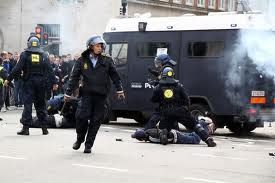 In this post I refer to an Internet site that gives a good idea of the many hooligan firms and the different countries involved. This site is against any form of violence and only a site for enlightenment.
In this post I refer to an Internet site that gives a good idea of the many hooligan firms and the different countries involved. This site is against any form of violence and only a site for enlightenment.Millwall Bushwackers are one of the notorious hooligan firms from London. They have been involved in more incidents than any others. The club has many critics, but they do not care as song in the chant, “No one likes us, we don’t care.”
You can read more about incidents and clashes at: http://www.football-hooligans.org/millwall-bushwackers-hooligans.html

West Ham Hooligans ICF – Inter City Firm. This is another London firm, which has taken its name from the rail network when travelling to other firms for fighting. The firm are famous for leaving a note saying, “Congratulations, You have just met the IFC.” This would be after crashing a pub or beating other firms.
West Ham are often used in films such as Hooligans where Millwall play an important role, but also in the movie Cass, describing Cass Pennants way to the leading position of the firm taking in mind his colour and the racism in many of the firms including Millwall.
Read more on: http://www.football-hooligans.org/westham-intercityfirm-hooligans.html
Other notorious hooligan firms:
Man Utd red army
Birmingham Zulus
Leeds service crew
Chelsea Head-hunters
Football hooliganism can be affected by society and this was the case as the communistic regime in Poland collapsed in the 1990’s. This meant a rise in unemployment and a failed economy, which were the causation of many young and frustrated men who had to cope through violence. This helped the increase of hooligans in Poland and today known as one of the most notorious countries of hooliganism.
Most countries affected by hooliganism have a history of economy failure, undereducated and unemployment.
Read more about these countries on: http://www.football-hooligans.org/countries.html
Website source 2 "Football Hooligans." Football Hooligans. Copyright 2008-2012, Web. 15 Mar. 2012.


